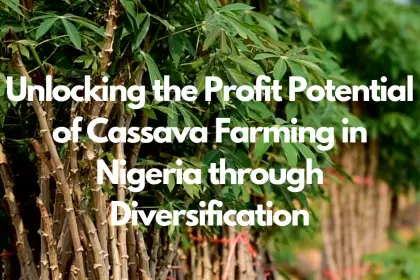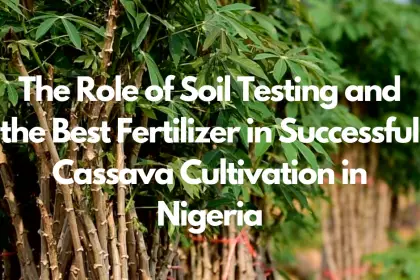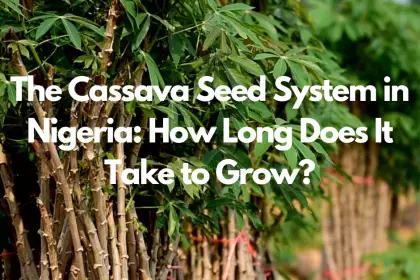Cassava production in Nigeria, a country renowned as the world’s largest producer, plays a pivotal role in the agricultural sector and offers immense economic potential. Originating from the Brazilian Amazon and cultivated for around 9,000 years, cassava has become integral to Nigeria’s agriculture due to its resilience to harsh climates and poor soil. This robust crop not only meets the domestic needs but also serves various industries with its starch-rich roots, highlighting the vast potential for economic growth and sustainability in regions where other crops may fail.
The landscape of cassava production in Nigeria is marked by the dedicated efforts of smallholder farmers and the significant contributions of women, who embody a substantial portion of the agricultural workforce. However, despite remarkable progress in yield and cultivation methods, the sector faces challenges such as pest infestations, inconsistent policies, and limited market access. This article explores real-life case studies to showcase innovative solutions and governmental policies shaping the success of cassava farming. It delves into sustainable practices that promise to enhance the economic potential of cassava leaves and roots, paving the way for a future where cassava production can thrive against all odds.
Historical Overview of Cassava Farming in Nigeria
Cassava production in Nigeria has evolved significantly since its introduction by Portuguese explorers in the 16th century, becoming a staple crop and a cornerstone of the country’s agricultural economy. The journey of cassava from a mere subsistence crop to the forefront of agricultural export and industrial use is marked by several key developments:
- Government Programs and Interventions: Since the 1970s, Nigeria has launched numerous initiatives to bolster cassava production, processing, and marketing. Notable among these are the National Accelerated Food Production Program (NAFPP), Operation Feed the Nation (OFN), Agricultural Development Projects (ADPs), and the Presidential Initiative on Cassava, which significantly contributed to the yield increase from 2002-2007.
- Production and Consumption Trends:
-
- Annual Output: Nigeria stands as the world’s largest cassava producer, with an output exceeding 34 million tonnes of tuberous roots.
- Usage: Predominantly, cassava is utilized for human consumption, with less than 5% directed towards industrial applications. Approximately 70% of the crop is processed into garri, a staple food in Nigerian cuisine.
- Challenges and Future Directions:
-
- Despite advancements, the cassava subsector faces challenges like pests and diseases, agronomic issues, and inconsistent policy measures. Future strategies emphasize the development and dissemination of improved cassava varieties to enhance productivity and diversity in cassava farming.
This historical overview underscores the economic potential of cassava production in Nigeria, highlighting the crop’s significance in feeding a growing population and contributing to the country’s agricultural prosperity.
Case Study 1: Enhancing Cassava Yield through Innovative Farming Techniques
Enhancing cassava yield in Nigeria involves adopting innovative farming techniques that have shown promise in other major cassava-producing countries such as Brazil, India, and Thailand. These countries have achieved remarkable yields of 25-40 tonnes per hectare, a target that Nigeria could attain or even surpass by implementing improved varieties and agronomic practices. The key strategies include:
- Intensive Farming and Monocropping:
-
- Transition towards monocropping on larger fields.
- Adoption of high-yielding genotypes suited for industrial uses.
- Advanced Agricultural Practices:
-
- Increased use of irrigation and agrochemicals to support crop growth.
- Implementation of integrated pest and disease management strategies to mitigate the increased prevalence of pests and diseases due to intensification.
- Sustainable Farming Techniques:
-
- Adoption of the FAO’s “Save and Grow” farming systems which emphasize soil health, zero tillage, and maintaining a protective organic cover on the soil surface.
- Utilization of mulching and intercropping with early maturing crops to protect soil, reduce erosion, and inhibit weed growth, thereby enhancing sustainability and yield.
Furthermore, the adoption of improved cassava varieties such as TME419, which boasts a high adoption score among small-scale farmers in North Central Nigeria, alongside mechanization and climate-resilient practices, are pivotal. However, overcoming challenges like inadequate extension services remains crucial for the widespread adoption of these innovations.
Case Study 2: The Role of Government Policies in Shaping Cassava Farming Success
Adetunji’s (2022) study underscores the detrimental impact of policy instability on cassava businesses and livelihoods in Nigeria, highlighting the urgent need for:
- Enhanced government support and local government engagement in agricultural policies.
- Consistency in policies to foster a stable environment for cassava production.
- Promotion of high-yield cassava stems and the commercialization of the cassava crop.
The International Fund for Agricultural Development (IFAD)-assisted Cassava Multiplication Programme (CMP) has been pivotal in:
- Large-scale planting material multiplication and distribution.
- Facilitating the development and rapid dissemination of improved cassava varieties.
- Extending improved agronomic practices and supporting processing prototypes.
The Cassava Flour (Mandatory Inclusion in Edible Flour Production) Bill, 2022 SB923, introduces a comprehensive framework aimed at:
- Encouraging cassava farming and creating a sustainable market for cassava flour.
- Establishing a National Cassava Policy Coordination Council for policy initiation and implementation.
- Mandating the inclusion of cassava flour in edible flour production, with NAFDAC setting and ensuring compliance with production standards.
These governmental policies and programs collectively aim to bolster cassava production in Nigeria, addressing key challenges while unlocking the economic potential of cassava farming.
Sustainable Cassava Farming Practices
To ensure sustainable cassava farming practices, the following strategies are recommended, drawing from successful case studies in Momo Division, Cameroon, and Kwara and Nasarawa States in Nigeria:
- Infrastructure and Capacity Building:
-
- Improvement of social amenities and road infrastructure to facilitate easy access to markets.
- Provision of farm cultivation and processing equipment alongside quality seed material.
- Capacity building of farmers for enhanced self-sustainability.
- Crop Management and Soil Health Preservation:
-
- Crop Management: The most prevalent sustainable practice among cassava farmers, with 59.2% adoption in specific regions of Nigeria. It includes:
-
- Protecting soil structure and organic matter by limiting mechanical soil disturbance.
- Maintaining a protective organic cover using crops and mulches to reduce erosion, conserve soil water and nutrients, and suppress weeds.
- Cultivating a wider range of plant species in associations, sequences, and rotations to maintain soil fertility and crop productivity.
- Tillage Practices:
-
- Zero Tillage: Promotes root functioning, builds up organic matter, maintains soil aggregate stability, and can produce high yields once soil health is restored.
- Conventional Ridge Tillage: Yields can be up to 46% higher than in untilled fields, although zero tillage is more commonly practiced among local farmers.
These practices collectively aim to enhance the sustainability and productivity of cassava production in Nigeria, ensuring the economic potential of cassava farming is fully realized.
Challenges and Opportunities in Cassava Farming
In the realm of cassava production in Nigeria, the sector encounters numerous challenges that, if addressed, could unlock significant opportunities for economic growth and development. These challenges and opportunities can be categorized as follows:
Challenges:
- Policy and Economic Environment:
-
- Inappropriate macroeconomic and sector policies have adversely affected the agricultural sector.
- Policy inconsistency has led to losses for cassava processors and limited food production.
- Production and Processing Inefficiencies:
-
- A staggering 52% of cassava output is wasted due to production and processing inefficiencies.
- Challenges such as pests and diseases, poor soil quality, and inadequate access to quality planting materials further exacerbate the situation.
- Infrastructure and Financial Constraints:
-
- The high cost of mechanization and inadequate capital investment in infrastructure have hindered cassava processing and food production.
- Stringent credit facility conditions have restricted access to capital for cassava processors.
Opportunities:
- Agro-Industrial Development:
-
- Encouraging product diversification and agro-processing can significantly contribute to employment and wealth creation.
- Cassava processing facilities are transforming cassava into a variety of products, creating value chains and job opportunities.
- Export Potential:
-
- Nigeria has a comparative advantage in cassava exports, with the potential to become a major player in the global market for cassava-based products.
- A thriving cassava industry contributes to improved food security by ensuring a stable supply of this staple crop.
Addressing these challenges requires a concerted effort from all stakeholders, including the government, private sector, and farming communities, to implement sustainable solutions that will enhance the economic potential of cassava production in Nigeria.
Conclusion
Throughout this article, we’ve explored the multifaceted significance of cassava farming in Nigeria, from its historical roots and development over centuries to the innovative agricultural practices and governmental policies that shape its current state and future potential. The real-life case studies demonstrate the critical role cassava plays within Nigeria’s agricultural sector, underscoring the employment and economic opportunities it offers while facing the challenges of pest infestations, policy instability, and the need for infrastructure improvement. These insights highlight the importance of continued innovation, policy consistency, and sustainable practices in realizing the full economic potential of cassava farming.
As we look to the future, the advancement of cassava farming in Nigeria appears promising, contingent upon the collective efforts of the government, private sector, and farming communities to address existing challenges. Emphasizing sustainable agricultural practices, bolstering infrastructure, and fostering a stable policy environment will be paramount in enhancing productivity and profitability. By capitalizing on the opportunities presented through increased efficiency, diversification, and export potential, cassava farming stands to significantly contribute to Nigeria’s economic growth and food security, paving the way for a prosperous future in the realm of agriculture.
FAQs
What are the key factors for achieving success in cassava cultivation?
To achieve success in cassava farming, it is crucial to maintain a planting density of 6,000 to 10,000 plants per hectare, which translates to a spacing of 1.5 x 1 meter or 1 x 1 meter for single cultivation. For intercropping, a spacing of 2 x 2 meters is recommended, resulting in about 2,500 plants per hectare. Additionally, integrating cassava with other crops can enhance agricultural profitability and soil health.
What obstacles do cassava farmers encounter?
Cassava farmers face several challenges including a lengthy maturation period, variability in dry matter and starch content, high levels of cyanogenic compounds, subpar cooking qualities, and diseases such as cassava bacterial blight and root rot, particularly in forested regions.
Which region in Nigeria is the leading producer of cassava?
Benue State holds the distinction of being the foremost cassava-producing region in Nigeria.
Can you outline the primary stages involved in cassava farming?
The five main stages in cassava farming are as follows:
- Selecting an appropriate site for the farmland.
- Preparing the soil for planting.
- Choosing the right cassava variety to plant.
- Acquiring the necessary equipment.
- Establishing an irrigation system.
- Understanding the climatic conditions suitable for cassava.
- Planting the cassava stems.
- Implementing effective weed control measures.











